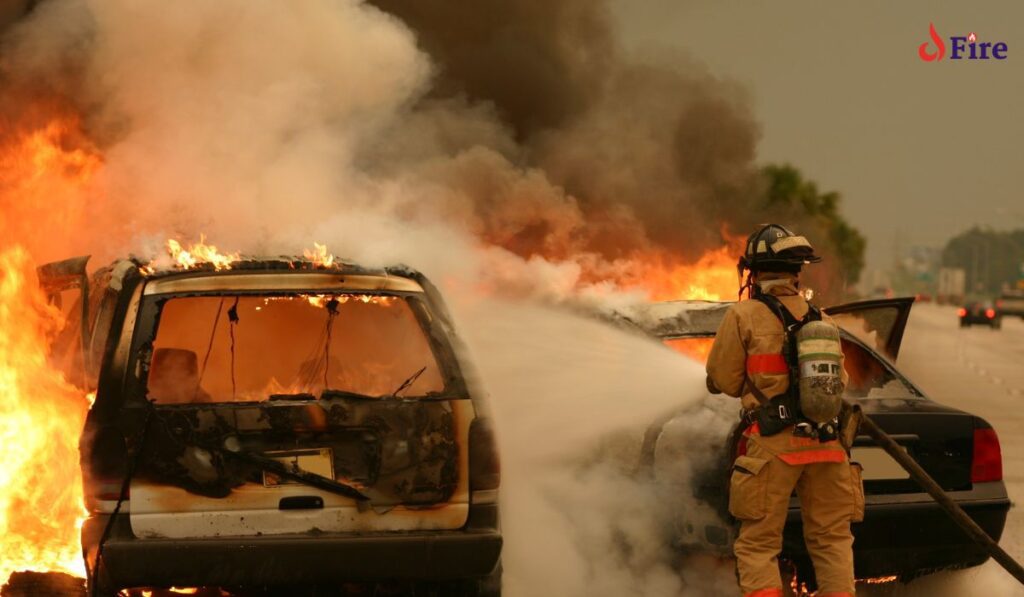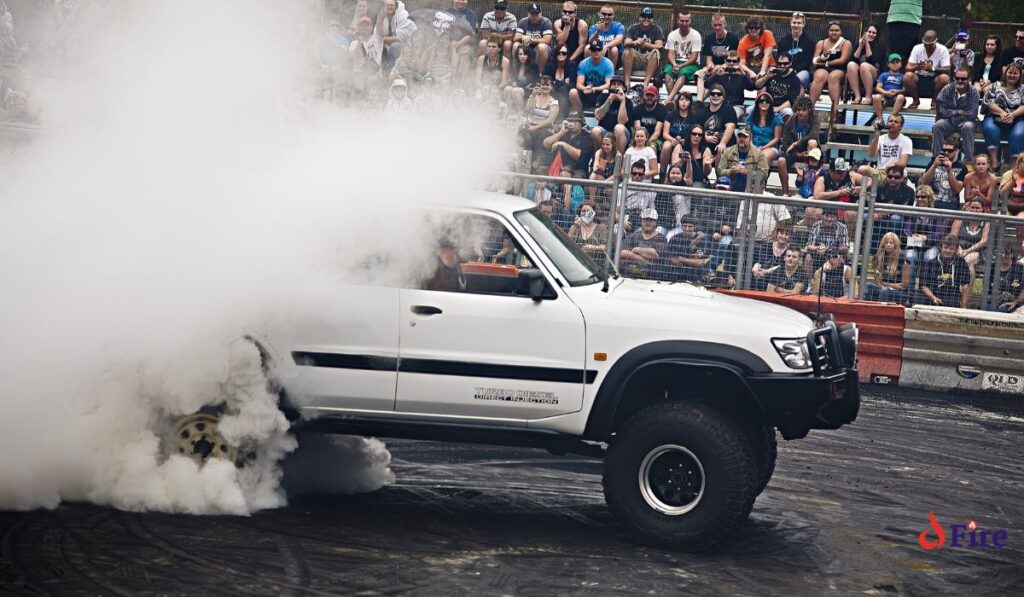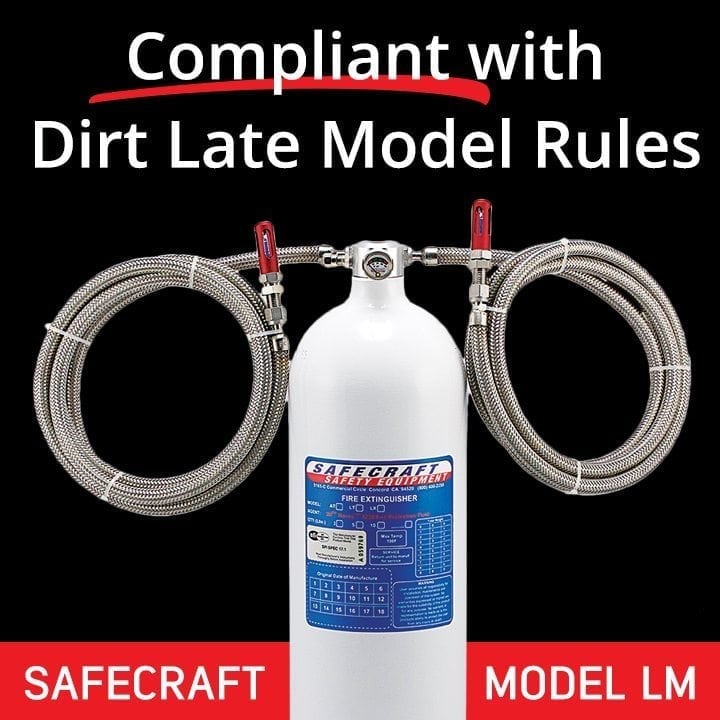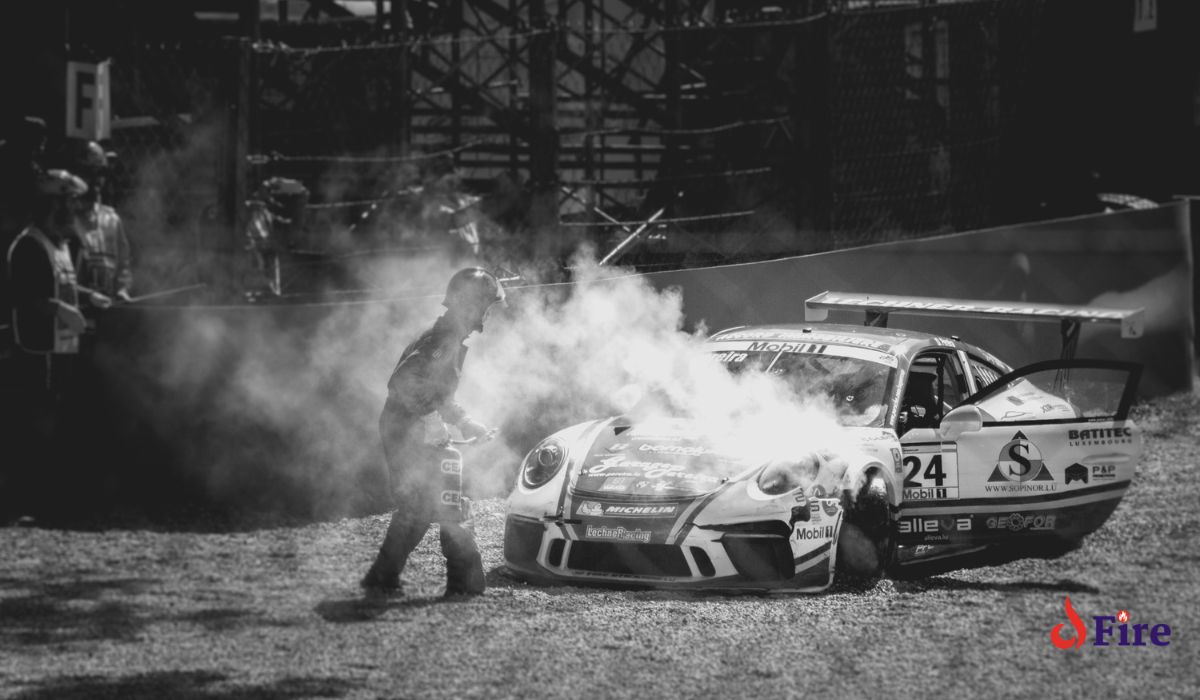A race car fire suppression system is a critical safety feature designed to extinguish fires quickly in race vehicles. It is mandatory in professional motorsport categories.
These systems use a combination of heat sensors and extinguishing agents, typically foam or gas, to detect and suffocate flames at their source, protecting both the driver and the vehicle. Installation must comply with regulations set by governing bodies like FIA or NASCAR, ensuring maximum safety during high-speed racing events.
Regular maintenance is necessary to keep these systems functional, as they can be the difference between life and death in the event of a fire outbreak. With technological advancements, modern fire suppression systems are lightweight, efficient, and can be easily integrated into the racing car’s design, adding minimal weight while offering maximum protection.

Credit: www.autosport.com
The Importance Of Fire Suppression In Motorsports
Revving engines. Roaring crowds. Heart-pounding speed. In the electrifying realm of motorsports, safety stands as a silent sentinel, crucial yet unobtrusive. At the core of this vigilance is the race car fire suppression system, a pivotal innovation designed to combat one of racing’s most fearsome hazards: fire.
Risks Of Fire On The Racetrack
Drivers hurtle down the asphalt at breakneck speeds, pushing their machines to the limit. In this high-octane environment, fire risk is ever-present. A mere spark can ignite a catastrophic blaze, fueled by high-performance engines, flammable fluids, and composite materials.
- Engine failures can create hot spots capable of ignition.
- Collisions may rupture fuel lines, spewing volatile liquids.
- High temperatures and friction are constant threats.
Historic Incidents And Safety Evolution
| Year | Incident | Outcomes |
|---|---|---|
| 1973 | Formula One crash | Fire suppression became a mandated focus. |
| 1986 | Sportscar race accident | Advancements in personal protective gear. |
| 1994 | Formula One tragedy | Overhaul of fire safety systems. |
The progression from tragedy to technological advancement serves as a stark reminder: fire suppression systems are no luxury; they’re an absolute necessity. Lessons learned fuel the continuous evolution of safety mechanisms in the relentless pursuit of crash survival.
Types Of Fire Suppression Systems
Think of race car drivers, and you picture speed, helmets, and the roar of engines. Yet, safety is key. Cars fly down tracks. Fires can start. This is where fire suppression systems come in. These systems are life savers. Let’s look at various types.
Halogenated Agents
These are chemicals that stop fires fast. They smother flames by cutting off oxygen. They also cool the fire. This type works great for small spaces. Think of it like a fire blanket. It’s wrapped around the flames. No oxygen, no fire.
- Popular in race cars
- Safe for drivers
- Quick to react
Foam-based Systems
Foam is used to cover fires. It forms a barrier. This barrier stops the fire. Flames can’t reach fuel. No fuel, no fire. Foam can cover a lot. It protects the car’s important parts. Drivers use it to escape fires.
- Covers large areas
- Separates fuel from flames
- Provides escape time
Gas-based Solutions
Think invisible firefighters. That’s gas-based systems. They release gases to stop fires. These gases are clean. They don’t leave residue. They’re safe for the environment. Best part? They don’t harm the car parts.
| Pros | Cons |
|---|---|
| Clean | Higher cost |
| Eco-friendly | Needs tight seals |
| Safe for parts | Special storage |
Key Components Of Race Car Fire Systems

The safety of race car drivers is paramount.
A crucial aspect is the fire suppression system.
This system contains key components.
Each part plays a vital role in fire safety.
Let’s explore these components:
Fire Suppression Bottles
Stored under pressure, these bottles are the system’s core.
They contain the fire-extinguishing agent.
Materials are usually steel or lightweight aluminum.
They come in different sizes based on car size and rules.
Nozzles And Tubing
Nozzles disperse the extinguishing agent.
Tubing connects the nozzles to the bottles.
The system can release foam, gas, or liquid.
Placement ensures quick-fire targeting.
Actuators And Triggers
Actuators release the suppressant.
Manual or automatic triggers activate them.
Manual versions need driver action.
Automatic ones detect heat or flames.
How Fire Suppression Systems Work
Imagine a race car zipping around the track at high speed. Suddenly, a fire erupts! The heart of driver safety lies within the fire suppression system. These systems are designed to stop fires quickly and effectively, protecting both the driver and the high-value race car. Let’s dive into how these life-saving systems operate.
Automatic Vs. Manual Activation
Two main types of systems protect cars from fire: automatic and manual.
- Automatic systems detect fire or a significant temperature rise and activate without driver input.
- Manual systems require the driver or a crew member to activate them in case of fire.
Automatic systems use sensors to trigger the suppression, while manual ones rely on human intervention. Both types have their place in racing safety.
Dispersion Techniques And Effectiveness
Once activated, the suppression agent must reach the fire. This is crucial for system effectiveness.
- Some systems use gas to smother the fire.
- Others spray foam that cools and coats the fire area.
- A few systems even disperse powder that interrupts the fire’s chemical reactions.
Different materials affect how quickly and effectively a fire is stopped. The choice depends on the car and race conditions.
Response Time And Temperature Thresholds
| System Feature | Importance |
|---|---|
| Response Time | The speed at which a system activates. Faster is better. |
| Temperature Threshold | The heat level is what triggers an automatic system. It must be well-calibrated. |
Effective systems balance quick responses with minimal false alarms. Proper maintenance ensures they work when needed most.
Installation And Maintenance Best Practices

The importance of Race Car Fire Suppression Systems cannot be overstated. Proper installation and maintenance are the key factors that ensure these lifesaving systems function effectively. Let’s delve into the best practices for installation and regular upkeep to keep drivers safe on the track.
Proper Mounting And Positioning
Ensuring a fire suppression system is correctly installed is crucial. It begins with choosing a secure, accessible location. Follow these steps for ideal mounting:
- Mount the tank in a position that will remain clear of collision damage.
- Use solid mounts to prevent the system from dislodging during an accident.
- Position nozzles to cover all critical areas: engine bay, cockpit, and fuel cell.
Nozzle orientation directly influences effectiveness.
Regular Inspections And Servicing
Consistent inspections guarantee system readiness. Adhere to these guidelines:
- Check for physical damages monthly, especially after events.
- Inspect hoses and nozzles for clogs or deterioration.
- Test the triggering mechanism to ensure a swift response during emergencies.
Maintenance records assist in tracking system health over time.
System Refilling And Upgrades
Properly refilling and upgrading components is essential. Consider these points:
| Refilling Interval | Upgrade Consideration |
|---|---|
| Immediately after discharge | Compatibility with new racing guidelines |
| After expiration date | Advances in fire suppression technology |
Use only the recommended extinguishing agents for refills. Newer, lighter, and more efficient systems become available regularly. Stay updated.

Credit: safecraft.com
Racing Regulations And Fire System Requirements
The thrill of race car driving comes with risks.
Safety regulations are critical. They protect drivers, teams, and spectators.
One key safety component is the fire suppression system.
Regulations define fire system requirements for racing vehicles.
Let’s explore the rules and standards that keep racers safe.
Fia Standards And Guidelines
The FIA, or Fédération Internationale de l’Automobile, sets safety standards.
Their guidelines are strict. They require fire suppression systems in all race cars.
These must handle a variety of fire types. They ensure a quick and effective response during emergencies.
- Systems must be accessible to drivers and safety personnel.
- They should be able to withstand high temperatures and severe impacts.
- Installation must follow the FIA’s precise directions.
National And International Rulebooks
Different countries have rulebooks.
They follow similar FIA guidelines.
There might be additional rules.
It’s vital to check these for each racing event.
| Country | Rulebook | Key Focus |
|---|---|---|
| USA | NASCAR Regulations | Car-specific requirements |
| UK | MSUK Regulations | Driver’s safety gear |
| EU | FIA European Standards | System testing, certification |
Periodic Rule Changes And Updates
Racing organizations update rules often.
They aim for greater safety.
Teams must stay current with changes.
Missing an update can mean disqualification.
- Check for updates before each race season.
- Review the technical bulletins for changes.
- Ensure systems are up-to-date and compliant.
Selecting The Right System For Your Racing Car
Choosing a fire suppression system for your race car is crucial. The correct one can save lives and investments. This guide will help you pick the best system for your needs.
Vehicle Specific Needs
Different racing cars have unique requirements. Identify your vehicle’s specific needs before selecting a fire suppression system. Consider engine size, fuel type, and car layout.
Budget Considerations
Fire suppression systems vary in cost. Set a realistic budget. Don’t compromise on safety for cost, but look for the best value within your budget.
Performance Vs. Safety Prioritization
Weigh the importance of performance against safety. High-end systems may add weight but offer better protection. Choose the balance that aligns with your racing priorities.

Credit: www.roguefab.com
Training For Emergencies: Drivers And Crew
Race car fires pose serious risks to drivers and pit crew members alike. That’s why rigorous training for emergencies isn’t just essential; it’s a critical component of racing safety protocols. Both drivers and crews must know how to act fast. They need comprehensive training to handle fire outbreaks effectively.
Mock Drills And Simulation
Mock drills and simulations are crucial for preparing teams for real-world emergencies. These exercises reinforce protocols and ensure team members can respond automatically under pressure.
- Conduct regular fire drill sessions.
- Use realistic simulations to mimic race day scenarios.
- Time response actions for efficiency.
Quick Exit Strategies
Drivers must exit vehicles swiftly during a fire incident. Quick exit strategies save lives. Crew members also need clear paths to safety.
- Practice seatbelt release and exit procedures.
- Ensure the cockpit design allows fast evacuations.
- Perfect the coordination between driver and crew.
Fire Safety Awareness And Readiness
Knowledge is power, especially when it comes to fire safety. Drivers and crew members should understand the types of fire suppressants used and the basics of fire behavior.
| FIRE SUPPRESSANT | APPLICATION | TRAINING FOCUS |
|---|---|---|
| AFFF (Aqueous Film Forming Foam) | Fuel fires | Suppressant handling |
| Halotron | Electrical fires | Safe application techniques |
| Carbon Dioxide | Interior fires | Timely deployment |
The Future Of Fire Suppression In Racing
Thrilling speeds and high-octane action define car racing. Safety is crucial. Innovations in fire suppression are key to racer safety. Our focus is on futuristic advances that make racing safer.
Technological Advances
Fire suppression technology evolves fast. New materials and smart systems lead the way. These materials resist heat better. They extinguish flames quickly.
- Fire extinguishing agents have shifted from traditional foams to cleaner, more effective gases and fluids.
- Electronic systems detect fires early. They warn drivers. They activate suppression without driver input.
- Smart sensors pinpoint fire locations. They direct suppression efforts for maximum effectiveness.
Integration With Other Safety Systems
Safety systems work together now. Fire suppression links with data recorders and telemetry.
- Telemetry alerts pit crews to possible fire incidents.
- Data recorders track vehicle performance. They predict potential fire hazards.
- Integration reduces risks. It leads to swift, coordinated emergency responses.
Seat belts, roll cages, and nomex suits also connect to suppression systems. This ensures rapid safety measures during fires.
Evolving With New Powertrains
Car racing sees hybrid and electric power more now. Fire suppression adapts to these changes.
- Systems address lithium battery fires. They require specific extinguishing agents.
- Suppression techniques focus on high-voltage components.
- Manufacturers develop solutions for various energy sources.
New extinguisher formulas target different fire types. They reflect the varied energy sources powering modern race cars.
Case Studies: Fire Suppression Systems In Action
Fire suppression systems are vital for safety in race car driving. They can be the difference between a minor incident and a major tragedy. By exploring actual case studies, we can understand their importance better. Here, we look at real-world examples where these systems have proven critical, what we can learn from times they haven’t worked as expected, and the impact on those who rely on them the most.
Successful Interventions
Racetracks have witnessed many fires extinguished quickly thanks to well-designed suppression systems. One such case occurred during a high-stakes championship race when a vehicle caught fire after a collision. The automatic system activated within seconds, spraying retardant and allowing the driver to escape unharmed. This incident underscores the system’s speed and reliability.
Lessons Learned From System Failures
Not all fire suppression systems work perfectly. One notable example was a system failure due to a dislodged connector during a crash. As a result, the system did not activate. After investigating, manufacturers made design improvements to prevent future failures. This case teaches us the value of regular maintenance checks and system audits.
Feedback From Drivers And Teams
- “Life-saving” – a common word drivers use.
- Teams demand reliability, easy maintenance, and quick activation.
- Preference for lightweight systems that don’t affect performance.
Frequently Asked Questions For Race Car Fire Suppression System
What Is A Race Car Fire Suppression System?
A race car fire suppression system is an on-board safety mechanism designed to extinguish fires quickly in the event of an accident or engine failure.
How Does Fire Suppression Work In Race Cars?
Fire suppression systems in race cars work by dispersing extinguishing agents, like foam or clean agents, rapidly to suffocate flames and prevent reignition.
What Types of Extinguishants Are Used in Racing?
Racing fire suppression systems typically use either Aqueous Film Forming Foam (AFFF), gas agents like Novac 1230, or dry chemical powders.
Are Fire Suppression Systems Mandatory In Racing?
Yes, fire suppression systems are mandatory in most racing series for driver safety and to meet stringent safety regulations.
How to Maintain a Race Car Fire System?
Maintain a race car fire system by performing regular inspections, checking for expired components, and ensuring nozzles and hoses are obstruction-free.
Can Race Car Fire Systems Be Manually Activated?
Most race car fire suppression systems can be manually activated by the driver or automatically triggered by onboard sensors during a fire.
Conclusion
Ensuring the safety of race car drivers is paramount. A robust fire suppression system is a critical component. It offers peace of mind and potentially life-saving advantages. Keep up with advances and maintenance for optimal protection. Remember, preparedness on the track saves more than just time – it saves lives.

I’m Abdus Sobur, a highly skilled and professional Fire Safety Officer with a passion for safeguarding lives and property. Over the course of my career, I’ve conducted numerous successful fire safety audits, earning a reputation for excellence in ensuring public safety.
In addition to my role as a Fire Safety Officer, I’m also dedicated to raising awareness about the importance of fire safety. Through my blog, I share insights into the functions of different fire safety equipment, aiming to empower individuals with the knowledge they need to protect themselves and their communities.
I’m driven by a deep commitment to promoting fire safety awareness and preventing fire-related incidents.

